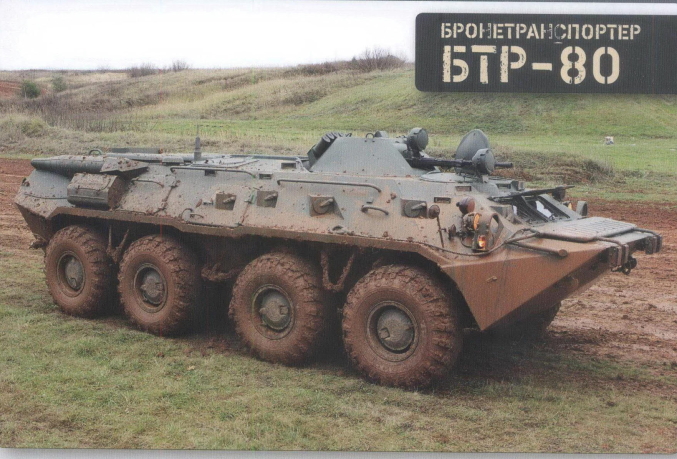
BTR-80 during amphibious operations. Note Snorkel equipment applied at rear to ensure air flow to and from the engine.
BTR-82A IFV variant with a remote controlled 30 mm turret mounted auto-cannon
The BTR-80 is a Russian 8×8 wheeled armored personnel carrier (APC) that is a continued development of the BTR legacy vehicles, the BTR-60 and the BTR-70. Introduced into Soviet inventories in 1986 and with over 5000 built the vehicle has become the backbone of Soviet rapid tactical mobility efforts and has been involved in extensive combat situations, with the Soviet war in Afghanistan being its initial baptism by fire. The vehicle is used by almost 40 countries including Afghanistan, Colombia, Hungary, India, Indonesia, Iraq, Kazakhstan, North Korea, Pakistan, Romania, Turkey and Ukraine.
The BTR-80 is a 30,000 pound (13.6 tonne) 8×8 wheeled APC which is approximately 25 feet (7.7 meters) long, 9.5 feet (2.9 meters) wide and 8 feet (2.4 meters) high. Operated by a crew of three with a driver, commander and gunner the vehicle also transport 7 infantry troops. The driver and commander are situated to the forward of the vehicle while the gunner is positioned in a roof mounted seat beneath the main weapon. Two of the troops are located forward of the driver and commander, while the other five sit on bench style seats in the back of the vehicle. The troops are provided with firing ports. The rear positioned troops enter and exit the vehicle through side doors that are split. The upper door swings to the side and the lower half descends downward, thereby acting as a stepping surface. This approach is supposed to let troops exit the vehicle while it is in motion, with the side of the vehicle having the doorway oriented away from enemy fire.
The BTR-80 is powered by a 260 hp V-8 turbocharged diesel engine which provides a power-to-weight ratio of 17 hp/ton. This is a significant improvement over the dual gasoline engines that powered the earlier BTR-60 and BTR-70. Able to attain road speeds of up to 55 mph (90 km/hr) and having an operational range of 370 miles (600 kms) with on-board fuel the vehicle is also fully amphibious with a water speed of 6.2 mph (10 km/hr). The vehicle is powered through the water through hydrojets. The vehicle is able to navigate a gradient of 60% and climb a vertical step of 1.6 feet (0.5 meters).
A large number of variants of the BTR-80 have been produced to meet various operational needs and customer requirements. The more common of these are noted below:
• BTR-80 – standard Armored Personnel Carrier (APC) produced in 1986.
• BTR-80M – enhanced version available in 1993 with improved engine and tires.
• BTR-82 – further enhanced version available in 2009 with increased armor, addition of spall liner, improved night vision equipment and a 300 hp engine.
• 2S23 – a fire support version of the vehicle, mounting a 120 mm mortar rifled gun.
• BTR-80A – An Infantry Fighting Vehicle version introduced in 1994 and equipped with the remotely operated 2A72 30 mm auto-cannon in the turret and provided with 300 rounds of ammunition.
• BTR-82AM – A Naval Infantry (Marines) version of the BTR-82A.
• BTR-82A – Further enhanced IFV introduced in 2009 that has been well received by Russian troops battling in Ukraine. Weapon system has a FCS and improved night vision optics. Includes increased armor, addition of spall liner to the vehicle interior, GLONASS navigation system and a 300 hp engine. The vehicle is also able to accommodate 8 dismounts.
The basic APC version of the BTR-80 is fitted with a turret that accommodates a 14.5 mm KPVT heavy machine gun and a 7.62 mm PKT co-axial machine gun. It is also equipped with a number of firing ports located along the front and sides of the vehicle that permit the dismounts to fire their personal weapons from inside the vehicle. The BTR-80 main weapon system is of a relatively simple design, in many ways antiquated for a current front line vehicles. The main weapon is not stabilized and therefore can only be fired accurately while the vehicle is stationary. And the mechanism for rotating the turret is manually operated. The gunner sits under the turret in a roof mounted chair that provides reasonable space claim, which is not typical for Russian vehicles. The gunner is provided a day time optical sight and an infrared night sight. The weapon can be elevated up to 60 degrees, providing the ability to engage low flying aircraft and targets situated on top of hills or located in high buildings (i.e., urban warfare).
The BTR-80 is of a welded ballistic steel construction which provides 14.5 mm ballistic protection along the front arc and small arms fire along the vehicle sides, rear and roofline. The dismounts sit in simple bench style seats which do not provide any Energy Attenuation in the event of a mine blast. The vehicle is equipped with six 81 mm smoke grenade launchers.
The BTR-80 has seen extensive combat in a number of theatres of war. These include the Soviet War in Afghanistan, the Nagorno-Karabakh War, the Georgian Civil War, the Turkish-Kurdish conflict, the Transnistria War, the Tajikistan Civil War, the First and Second Chechen Wars, the War of Dagestan, the 2008 South Ossetian War, the Iraqi insurgency and the War in Donbass.
During these conflicts the BTR-80 performed reasonably well considering its relatively light protection levels and lack of armor specific to protecting the vehicle from IEDs, RPGs, EFPs, heavy calibre ammunition, and underbelly blast events.